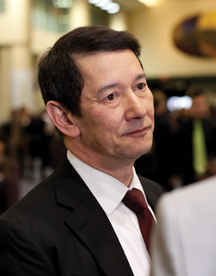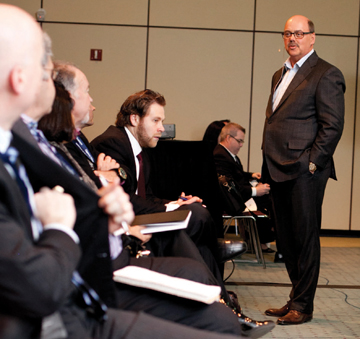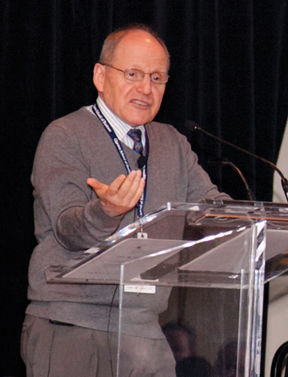Aligning with the Best

On March 27, nearly 2,000 members of Canada’s business elite converged on the Metro Toronto Convention Centre to celebrate their organizations’ status as Canada’s Best Managed Companies. Among the award presenters at the gala that evening was Dean David Saunders, representing the School’s long-time partnership in this prestigious national program. Introduced by TV personality Ben Mulroney and doing the honours before Juno Award-winning band Great Big Sea took the stage, the Dean helped honour the best of the best at this annual event that QSB has co-sponsored since 2001.
It was a 1998 call “out of the blue” asking Ken Wong, Distinguished Professor of Marketing, to be a speaker for the Best Managed program (then known as the 50 Best) that began the QSB connection. The following year he was asked to sit on the program’s adjudication panel. It was Ken’s involvement as a judge that ultimately led to QSB becoming a national partner. “I was impressed by the quality of the program,” he says. “It seemed like a great opportunity to align two first-class brands that were looking at the world through the same lens.”
There are many advantages the partnership affords QSB, most notably the chance to get in front of Canadian business leaders and management teams with Queen’s hallmark high-quality executive education, such as this year’s sessions led by QSB professors Douglas Reid, John Pliniussen and Julian Barling. Companies in the Best Managed network employ more than 250,000 people across Canada—a prime market for the School’s executive education offerings. Many of the executives in attendance are the prime decision makers on sourcing executive development opportunities for their employees.
Founded in 1993, Canada’s Best Managed Companies program offers a mark of excellence for Canadian-owned and-managed private companies with annual revenues above $10 million. Each year, hundreds of businesses vie for the honour of being selected a Best Managed company by undergoing a rigorous and independent process that evaluates their management capabilities and practices.
An adjudication panel chooses winners in four categories: first-time winners (the 50 Best); Requalified members that meet the criteria for two years in a row (57 this year); Gold Standard members that have requalified for four to six consecutive years (66 this year); and Platinum Club members (91 in total) that exceed six consecutive years.
 50 Best Judge, Prof. Ken Wong
50 Best Judge, Prof. Ken Wong
Serving on the adjudication panel alongside counterparts from Deloitte, CIBC, and the National Post, the program’s other sponsors, Ken Wong enjoys the opportunity to sit at the table with great minds. “It’s a parade of amazing case studies and a continuing education for me,” he explains. It also keeps him in touch with the evolution of business—a great benefit to the hundreds of students he teaches and mentors each year at the Business School.
The benefits winning companies receive are legion. They include extensive media coverage, use of the Best Managed logo, networking opportunities with fellow exceptional business leaders, access to QSB’s regular faculty-led webinars and year-round resources through the dedicated program site and the Best Managed channel on the FP Executive site. Professional development at the Best Managed Symposium is exclusive to program winners and this year featured The New Yorker magazine writer and renowned author Malcolm Gladwell as the keynote speaker, and presentations by Deloitte, QSB faculty and other leaders at the forefront of business thinking.
This year’s Symposium presentations by Professors Barling, Pliniussen and Reid covered topics that are top-of-mind in today’s challenging business environment: transformational leadership, creativity and innovation, and employee engagement. Here are some of the highlights from each of these well attended and top-rated presentations and reactions from some of the attendees.
Creativity and Innovation
Are you state-of-the-art or state-of-the-ark?
Implemented correctly, creativity and innovation are key factors in helping organizations boost revenues, margins, productivity and morale, said Professor John Pliniussen in his session’s introduction. An expert on innovation, sales management and e-marketing, he began by defining creativity as the ability to be resourceful. “Conceptual—as opposed to artistic—creativity focuses on identifying problems and finding solutions, filling a need relevant to an organization, team or stakeholders,” he explained. Innovation then kicks in when the team takes the best creative idea and implements it successfully.
 “Creativity is a skill that can be increased by practice and positive reinforcement,” said Prof. John Pliniussen.
“Creativity is a skill that can be increased by practice and positive reinforcement,” said Prof. John Pliniussen.
But what if you are part of an organization that is lacking in both? There is hope because creativity can be taught. “It’s a skill that can be increased by practice and positive reinforcement,” John assured the audience as he discussed new research showing how to spark creativity at work. Through a variety of case studies and video examples, he demonstrated how time devoted to examining a problem can produce the most innovative results.
Ultimately, organizations need to think creatively to get employees to do the same. Employee recognition, incentive and evaluation programs can be used to instill creative thinking. John suggested evaluating employees based on the number of ideas they put forward for product development or business improvement, for example. “If innovation is important, it needs to become part of your training and evaluation process,” he explained, noting that in business, what gets measured, gets done.
Davis Yung, EMBA’02, CEO of Fresh Direct, a fresh produce importer and wholesaler, was encouraged to learn that there are more structured ways to inspire innovation in the workplace, rather than relying on random efforts. “We plan to set goals and incentives to encourage creative and innovative ideas in our company,” he said. Operating out of western Canada with more than 100 employees, Davis and the Fresh Direct team were at the Symposium to celebrate their new status as one of Canada’s 50 Best Managed companies.
Celebrating the successes that result when creativity leads to positive change is another critical step, according to John. Jim Thorne, MBA’90, BA’87, planned to take this tip back to his company. As President and CEO of Marsan Foods, he left this session determined to find more ways to publicly celebrate and champion accomplishments and innovations of this Platinum Club company, a leading processor of private label frozen foods and branded healthcare products. “Marsan has done many innovative and creative things over the course of our 42 years in business, making us who we are today. But we are interested in taking it to the next level and creating a culture of creativity, so that our entire organization is engaged in finding ways to continuously improve. An important way to do that is to increase our celebration and recognition of great ideas.”
Beyond recognition programs, John addressed the direct correlation between a fun, creative environment and the talented people who are attracted to working in such a setting. It calls to mind an “If you build it, they will come” approach. In building that creative environment, organizations should think about diversity in thinking and training. “Big breakthroughs often come via cross-pollination and with the help of people from diverse areas of expertise,” John noted.
Throughout his engaging session, complete with YouTube video clips showing examples of creativity in action, John shared several tips to help improve organizational creativity. Here are just a few:
- Be hands on…build, create and fix things.
- Help people laugh, smile and relax.
- Hire or involve different thinking styles and preferences (left brain vs. right brain).
- Support imagination boosters—time, freedom, conversation, goals, even meditation.
- Ask questions—many questions! They lead to the greatest ideas.
- Leadership creates the culture of innovation.
- Build your creativity library—you are what you read.
- Use Queen’s School of Business to get ideas [www.execdev.com].
To read a Q&A with John, visit the Best Managed channel on FP executive
See John’s bio
Beyond Employee Engagement
Generating real attention, focus, and profitability
Through his teaching and consulting, Strategy Professor Douglas Reid has found that many executives believe that employee disengagement hinders organizational change. His session concentrated on how to improve engagement and, hence, an organization’s overall performance.
 “People want to be masters of their work, so enable them,” said Prof. Douglas Reid.
“People want to be masters of their work, so enable them,” said Prof. Douglas Reid.
An authority on competitive strategy with a focus on understanding how busy executives learn, Douglas believes that increased employee engagement may offer the sole remaining
opportunity for companies seeking a step-function improvement in productivity and competitiveness.
He began with a simple question: What does an organization with highly engaged employees look like? Engagement is not happiness, he explained. It’s exemplified by a focused workforce that demonstrates intensity, enthusiasm, persistence and proactivity and is also adaptable. This last attribute is key because engaging employees is a change process. Recent research from QSB showed that 20 percent of a workforce wants change, 10 percent will resist and 70 percent will be neutral. To make change happen and drive up engagement, organizations need at least 20 percent of this last group to move into the “wants change” category.
So what’s working in organizations that are seeking to improve employee engagement? Collaboration is the main driver. But to “get to we,” Douglas cautioned that management teams need to ensure that all employees have a clear sense of who “we” are. “Engagement is organizational culture,” he explained, citing the drastic cultural differences between Southwest Airlines (highly engaged) and Air Canada (fragmented). Management should take stock of how “we-centric” their organizational culture is.
This message, too, resonated with Davis Yung, who saw its application to his expanding fresh produce business. “One key take-away for me is to really understand the power of ‘we’ and determine how to get the team to ‘we’ more often.”
“Employee disengagement is a bad habit,” Douglas continued, “but, organizationally, which of our habits are we really prepared to change, permanently and forever?” While engagement is necessary, it is not sufficient for survival and growth, Douglas explained.
Engagement can be a competitive differentiator, he continued, citing Zappos.com as a prime example. “An employee’s relationship with the organization is not transactional. People want to be masters of their work, so enable them,” he urged, as Zappos did with its employee empowerment approach.
How do organizations get there? An employee engagement strategy that is tied to evaluation and championed at the board level is vital. Saying “there is no one-size-fits-all engagement policy,” Douglas advised his audience to “match what you are doing as an organization to the employees’ mandate.”
Michael Burrows, MBA’80, CEO of Maple Lodge Farms, chose this session to challenge himself to think differently about the vast resource he has in the company’s 2,500 employees across Canada. After taking in Douglas’s session, he plans to formalize an employee engagement strategy. “Employee engagement is a continuous journey and an aligned and committed strategy can make a difference.” Michael’s first step in the process is to do more listening, across all levels of the organization, and let employees’ feedback inform his strategy.
During the session, some indicators of a motivated work force were identified, including:
- Makes ground-breaking innovations
- Is inspirational
- Generates creativity
- Has positive energy
- Goes above and beyond
- Say their work doesn’t feel like work!
See Douglas Reid’s bio
Make an Impact
Transformational Leadership
Transformational leadership is a much discussed management theory and concept, but its implementation in the workplace is not well understood. QSB Organizational Behaviour professor Julian Barling’s session brought clarity to the topic by focusing on some of the critically important outcomes derived from transformational leadership and how these concepts can be applied in the workplace.
“Leaders hold in their hands the power to influence others,” said Julian. “And transformational leadership can do just that—it helps people change.” Research has shown that organizations or teams headed by transformational leaders have improved corporate performance as measured by such criteria as increased sales and employee creativity, and decreased absenteeism and turnover.
 “When you show people they are important, they will react as if they are,” said Prof. Julian Barling.
“When you show people they are important, they will react as if they are,” said Prof. Julian Barling.
“Faced with wonderful leadership, people will aspire to superior performance,” Julian said. To achieve this effect, leaders need to think about how they can elevate someone with their actions. The approach is employee-centric, not leader-centric, Julian told the audience.
He reported that people, not surprisingly, are remarkably responsive to the way in which they are treated. “When you show people they are important, they will react as if they are.”
Michael Burrows took great inspiration from Julian Barling’s talk. “You have an opportunity when engaging with employees to have a meaningful interaction and help them be all that they can be,” he said. He plans to do just that when he returns to the office by increasing his interaction with employees across the organization.
By far the most important characteristic of a transformational leader is humility, Julian explained. Using humour, which is appropriate and self-deprecating, and offering apologies are two ways a leader can demonstrate humility. Apologies, especially those that are properly executed, can rebuild trust with employees.
Employees watch and evaluate why leaders behave the way they do. Julian offered several examples of transformational leadership behaviours:
- “Walk the talk!” Employees trust and respect leaders who consistently choose to do the right thing, rather than the merely expedient.
- “Optimism is infectious!” Telling employees “you can do it” inspires them to go the extra mile and accomplish great things.
- “How would you solve this problem?” Encourage subordinates to think about work-related problems in new ways, provide them opportunities to develop, and prepare them for their next position in the organization.
- “What can I do to make my employees feel respected and appreciated?” Be compassionate (listen!), appreciate and recognize staff (say thank you!), and establish a relationship (use names, make eye contact).
“Ultimately, it’s the smallest things that leaders do that have the power to effect major changes in people’s lives and organizations,” he concluded.
See Julian's bio.
